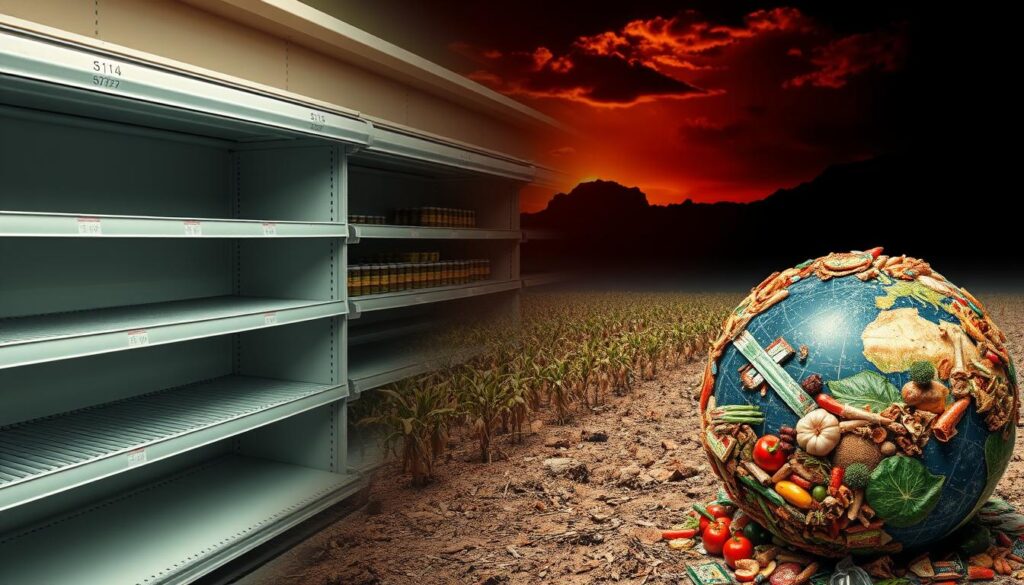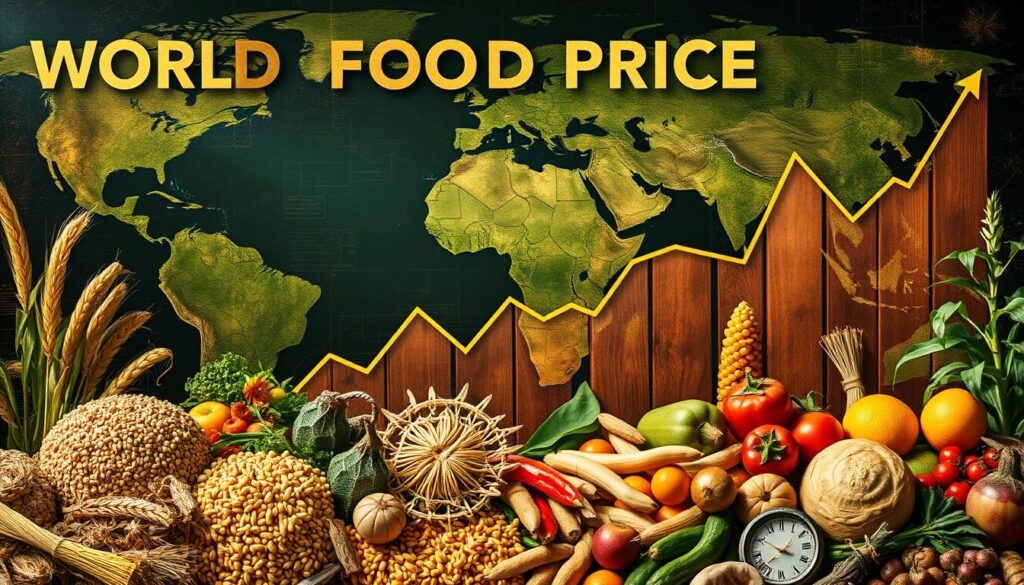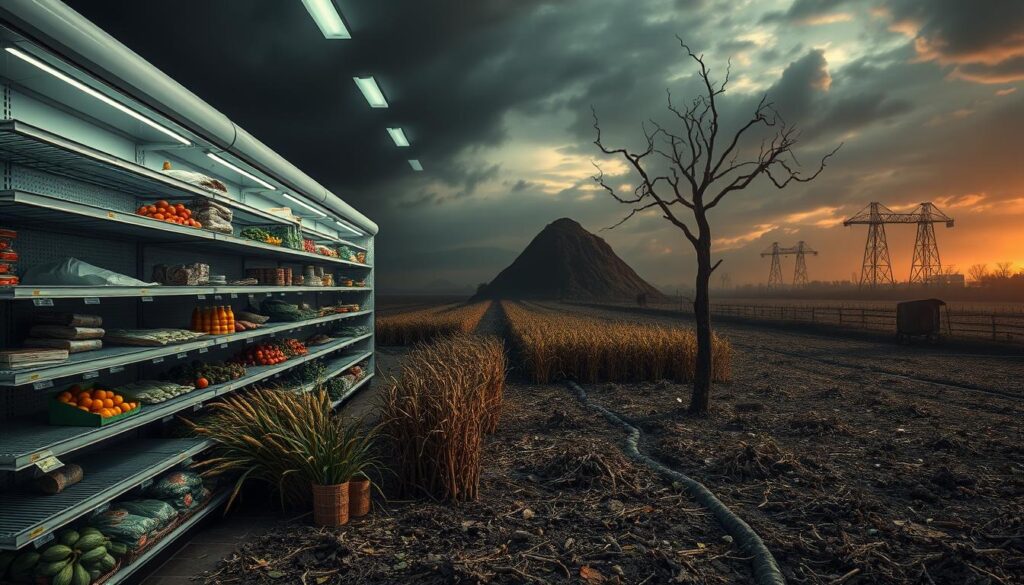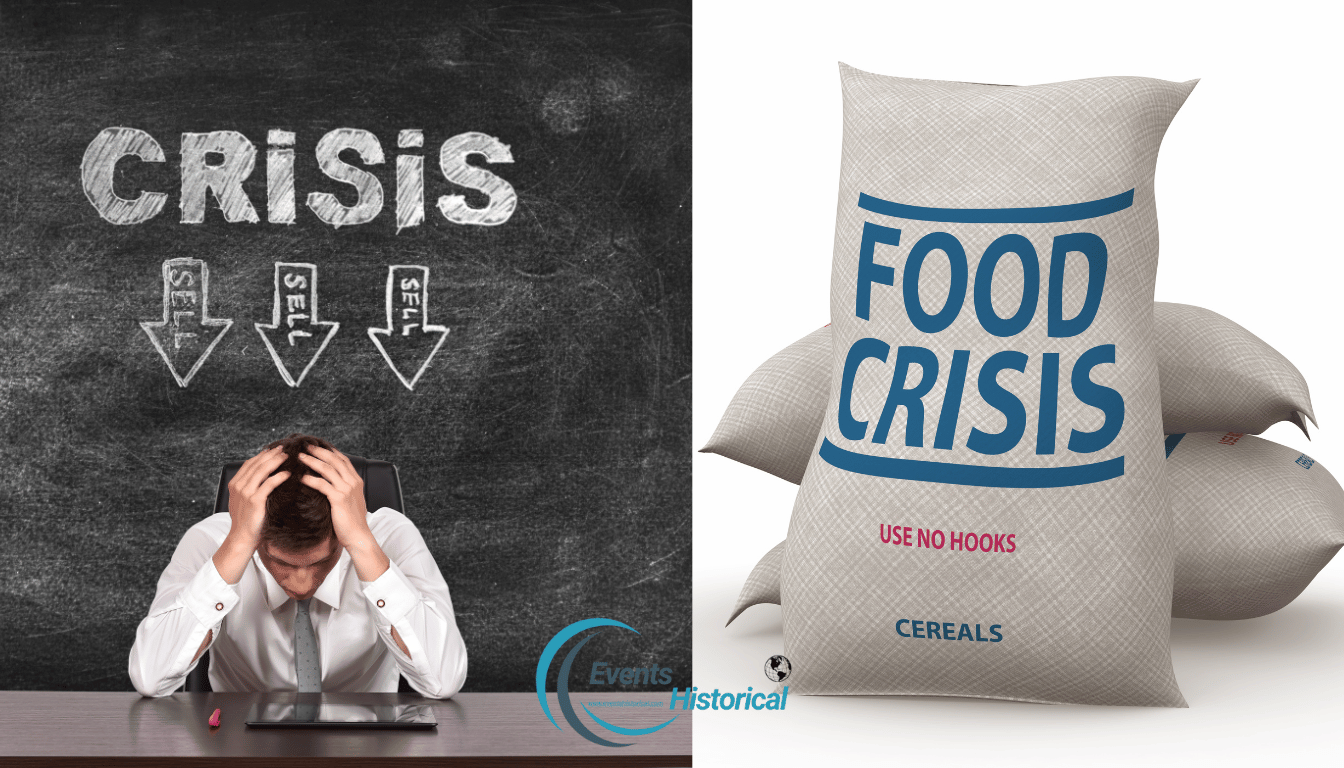Examine the Origin of the Global Food Price Crisis of 2007-2008, Impacts and Economic Costs. Learn about the effects of its occurrence to food security around the world and to markets.
In the two parts of the countries, and worldwide, a shocking food price crisis came in 2007/2008. That led to the increase of food prices for millions of families. This resulted in political instabilities and shifted significant concern about food issues throughout the globe.
So, what caused this crisis? And how did it affect the economy? We’ll explore the reasons behind the price surge, its impact on the poor, and what we learned from it.

Key Takeaways
- The global food price crisis of 2007-2008 was triggered by a perfect storm of factors, including droughts, rising oil and fertilizer prices, and the increasing demand for biofuels.
- The crisis had a devastating impact on the world’s poorest, pushing an estimated 130-155 million people into poverty.
- Vulnerable households, particularly in developing countries, were hit the hardest as they spent a large portion of their income on food purchases.
- High food prices and volatility led to social unrest, with food riots breaking out in various parts of the world.
- The crisis highlighted the need for greater investment in agriculture, targeted safety nets, and policy reforms to enhance global food security.
Overview of the Global Food Price Crisis
The food markets of the world experienced sharp hikes in food prices in 2007-2008 due to the global food price crisis. This has brought political and economic hardship in most parts of the globe. It led to scarcity of food, and instabilities, in the first world countries and the third world countries as well.
World Food Price Index and Price Surges
The Food and Agriculture Organization (FAO) food price index hit all-time highs. Prices for staples like rice, wheat, corn, and soybeans skyrocketed. For example, rice prices jumped by 217% between 2006 and 2008.
Political and Economic Instability
The sudden rise in food costs led to calls for food aid from 36 countries. It also sparked civil unrest and political instability in many places. The crisis showed how fragile the global food system is and the need to fix it.
| Commodity | Price Increase (2006-2008) |
|---|---|
| Rice | 217% |
| Wheat | 136% |
| Corn | 125% |
| Soybeans | 107% |
The food price crisis of 2007-2008 was a major wake-up call. It showed the importance of tackling the root causes of price hikes. We need to make the global food system more resilient.

Root Causes of the Food Price Spikes
The late 2000s saw a global food price crisis. It was caused by droughts, bad weather, and higher oil and fertilizer prices. These factors together led to a big jump in food prices around the world.
Droughts and Adverse Weather Conditions
Severe droughts hit major grain areas like Australia, Ukraine, and parts of the U.S. These droughts cut down crop yields. This reduced the global supply of wheat, corn, and rice.
The bad weather also messed up farming. It put a lot of pressure on the world’s food system.
Rising Oil and Fertilizer Prices
A major factor that resulted to food crisis was high oil prices. They increased the costs of food production, distribution and marketing of the food products. Oil prices done fertilizers more expensive as most of them depend on oil and gas.
It is emphasized that within six months, some fertilizers prices tripled. This was an ingredient for the increase in the food prices.
Prolonged droughts, bad weather, increasing oil prices and expensive fertilizer conspired to bring the food crisis experienced between 2007 and 2008. This is where it is important to find the reason why these price hikes occurred in time to solve food security problems and prevent similar crises.
| Cause | Impact |
|---|---|
| Droughts and Adverse Weather Conditions | Reduced crop yields, disrupted agricultural production, and strained the global food system. |
| Rising Oil and Fertilizer Prices | Increased production, transportation, and distribution costs, further exacerbating the food price crisis. |

Impact of Biofuel Production
The rise in biofuels in developed countries has led to a global food price crisis. The shift of crops like corn and soybeans to biofuels has reduced their availability. This has caused prices to soar, affecting both food and feed sources.
Between 2005 and 2007, agricultural commodity prices skyrocketed. The effect on food prices and household spending was less clear. Yet, food price indices from the World Bank and FAO saw significant increases during this time.
Biofuel policies in the EU and US are set to raise vegetable oil prices by over 30% by 2016. Prices for wheat, corn, and soybeans are also expected to jump by 3% to 15%. On the other hand, oilseed meal prices might drop by 11% to 17% due to increased vegetable oil production.
Freezing biofuel production at 2007 levels could lower prices of cassava, oils, sugar, and wheat by less than 10% by 2020. If biofuel production stopped in 2007, prices could drop by 10% to 20%.
Biofuel mandates are expected to most affect oilseeds, with prices rising by 25% to 72%. Grains prices are also set to increase by 5% to 21% across different regions.
The shift of food crops to biofuels is seen as a major cause of the 2008 global food price crisis. Policies to address this crisis depend on the principle of food sovereignty, as research suggests.
Increasing Food Demand in Emerging Economies
The growing middle class in emerging economies, especially in Asia, has changed how people eat. This shift has led to higher global food prices. Countries like India and China are seeing more people wanting to eat a variety of foods, including meat and dairy. This demand is putting a lot of pressure on the world’s farms, making food more expensive.
Dietary Changes and Rising Middle Class
The International Food Policy Research Institute says the rising middle class is changing what people eat. People in these countries are now looking for more variety in their diets, with a focus on animal products like meat and dairy. This new eating pattern is making it harder for the world to meet food needs, causing prices to go up.
| Country | Real Food Price Increase (2022) | Food Expenditure as % of Total Expenditure |
|---|---|---|
| Low-Income Countries | 4.4% | 42% |
| Middle-Low-Income Countries | 2.2% | 40% |
| Middle-High-Income Countries | 4% | 29% |
| High-Income Countries | 2% | 15% |
The data shows how food prices affect low-income and middle-income countries. Food takes up a big part of their budgets. This highlights the big challenge these countries face due to the growing demand for food.
“The gradual change in diet among newly prosperous populations in emerging economies, particularly in Asia, was a significant factor underlying the rise in global food prices.”
As the middle class in countries like India and China grows, so will the demand for different foods. This will put even more pressure on farms worldwide. It’s likely to make food prices go up even more in the future.
Role of Financial Speculation and Commodity Markets
The global food price crisis of 2007-2008 was complex. The role of financial speculation in commodity markets was a big topic of debate. Some say investment banks and hedge funds entering agricultural futures markets made prices jump up too high.
These speculators are seen as making prices more unstable. This has raised concerns for consumers, farmers, and governments. They want better rules and openness in these markets to stop the harm from financial speculation on global food prices.
| Statistic | Value |
|---|---|
| Increase in commodity index trader positions in 2000-2008 | $200 billion |
| Increase in FAO Food Price Index in 15 months (2006-2008) | 71% |
| Increase in rice and cereal prices in 15 months (2006-2008) | 126% |
The controversy over representational claims on futures trading and the impact on the high food price crisis continues. Others think that speculation distorted the efficiency of signaling concerning prices resulting in the exacerbation of the crisis. Some people argue that there exists but weak evidence and that markets are just too complicated. However, the fear is that speculation might continue to bring even more instability to food prices. Such findings underscore the need for a focus on new scientific studies and new legislation to improve the state of world food security.
Declining World Food Stockpiles
In the past, countries kept large food stockpiles to protect against supply problems. But, this practice has decreased. The growth in food production and the ease of importing food have made keeping big stockpiles less important.
In February 2008, the U.S. wheat stockpiles hit a 60-year low. This drop in global food stockpiles led to price hikes and market volatility in 2007-2008. With fewer reserves, the market became more prone to price swings.
| Statistic | Value |
|---|---|
| Proportion of food price increases from 2002 to 2008 attributable to dollar depreciation | Approximately 20% |
| Increase in commodity food price index from June 2007 to summer 2008 | 57% |
| Number of countries that implemented consumer-based subsidies in response to the food price crisis | Over 50 |
| Decrease in Argentine food production in 2009 due to agricultural restrictions | Significant reduction |
| Increase in global wheat prices from October 2021 to October 2022 | 18% |
| Increase in global maize prices from October 2021 to October 2022 | 27% |
| Increase in global rice prices from October 2021 to October 2022 | 10% |
The decline in food stockpiles, along with weather issues, higher oil and fertilizer costs, and more biofuel production, caused price spikes in 2007-2008. To ensure food security, it’s vital to rebuild food stockpiles. This will help the world be more resilient and less affected by future price shocks.
Global Food Price Crisis of 2007-2008: Causes, Effects, and Economic Consequence
The global food price crisis of 2007-2008 was a major event with wide-reaching effects. Rice prices soared by 224%, wheat by 108%, and corn by 89%, as reported by the International Food Policy Research Institute (IFPRI). This sharp increase in food prices led to food insecurity worldwide. It caused civil unrest in many countries and prompted 36 countries to ask for food aid.
Experts and policymakers agree that certain government policies worsened the crisis. These policies included export restrictions and panic buying. The crisis also had big economic impacts, affecting inflation, consumer spending, and global trade.
| Cause | Effect | Economic Consequence |
|---|---|---|
| Droughts and adverse weather conditions | Reduced crop yields and food production | Inflation, higher consumer prices |
| Rising oil and fertilizer prices | Increased cost of agricultural production | Reduced profit margins for farmers and food producers |
| Increased biofuel production | Diversion of food crops for fuel | Higher food prices, reduced food availability |
| Export restrictions and panic buying | Exacerbated price volatility and food shortages | Disruption of global trade and supply chains |
The 2007-2008 food price crisis had big economic effects. It hit both developed and developing economies hard. In developing countries, where food costs up to 45% of household budgets, it pushed 155 million people into extreme poverty.
As we face another global food crisis in 2022, we must learn from the past. We need to invest in sustainable farming, promote free trade in food, and help the most vulnerable. These steps are key to making our global food system more resilient.
Population Growth and Food Production
As the world’s population grows, worries about food demand rise. Yet, the link between population and food production is not simple. It’s more complex than it seems.
World Population Trends
The world’s population has grown steadily, but the growth rate has slowed down. Since the 1980s, the rate has dropped from 2.1% to about 1.1% today. This slowdown is significant.
- The global population hit 7.9 billion in 2022, up from 6.1 billion in 2000.
- The annual growth rate fell from 1.6% in the early 2000s to 1.1% now.
- Fertility rates have plummeted in many developing countries, leading to slower growth.
Even with a slower growth rate, the large population size demands more food. This creates big challenges for sustainable farming, resource use, and the environment.
“The world’s population has grown dramatically over the past century, but the rate of growth has slowed significantly in recent decades. Addressing the complex relationship between population, food production, and environmental sustainability will be crucial in the years ahead.”
Export Restrictions and Panic Buying
In 2007-2008, a global food price crisis hit hard. Major food-producing countries put export restrictions in place. This move, along with panic buying by other countries, made food prices skyrocket.
The International Food Policy Research Institute (IFPRI) found that export bans were a big reason for rice price hikes in 2008. When countries banned exports, importers panicked. They bought more food, which made prices go up even more.
The effects were huge. Studies found that policies during the 2010-11 food price spike raised wheat and maize prices by 40% and 25%, respectively. This crisis pushed 8.3 million people into poverty.
The Ripple Effect on Global Food Prices
The 2007-2008 crisis had a big impact worldwide. In August 2011, food prices reached an all-time high, pushing 105 million people into extreme poverty. Hunger and food insecurity soared, with 821 million undernourished people in 2017.
Food prices have dropped since 2007-08, but they’re still high. These high prices affect economies and people’s lives, causing inflation, reduced spending power, and less access to education and healthcare.
“The 2010–11 food price spike tipped 8.3 million people (nearly 1% of the world’s poor) into poverty.”
Policy Responses and Lessons Learned
The 2007-2008 global food price crisis made countries rethink their policies for volatile agricultural markets. They learned that targeted safety nets help the poor without hurting food production. These safety nets support vulnerable people’s buying power.
Countries cut tariffs on key food items to lower prices and ease consumer burdens. They also saw the need to boost investment in agriculture, especially in developing countries.
Targeted Safety Nets and Market-Based Responses
Governments set up targeted safety nets like cash transfers and food vouchers. These helped the poor deal with high food prices. Unlike blanket subsidies, these measures didn’t harm food production.
Market-based responses also became important. Futures and options markets helped manage price swings. Policymakers worked to make these markets more transparent to prevent price shocks.
Investment in Agricultural Sector
To tackle the crisis, countries and donors boosted investment in the agricultural sector. They tackled transportation issues and promoted market-based agriculture. This improved productivity and met growing food needs.
These actions have made global food systems more resilient. Yet, the risk of future price shocks is still there. Ongoing efforts and adaptation are key to ensuring food security for everyone.
Potential for Future Food Crises
The risk of future food crises is high. The 2007-2008 global food crisis was not fully solved. An IFPRI report shows that the 2008 crisis had similar causes as the 1972-1974 crisis. These included energy crises, changes in cereal demand, low interest rates, and weather issues.
This report says we might see these problems again. It points out that ignoring agricultural investments is a big threat to food security challenges. The 2008 crisis hurt many, making it hard for families in the U.S. to feed their kids. Food banks saw more families coming for help.
At least 100 million people could fall back into poverty because of the food crisis, the World Bank warned.
Here are some worrying facts about the potential for future food crises:
- Prices of staple foods doubled in a year.
- Prices of major commodities hit nearly fifty-year highs.
- The FAO price index rose by eight percent in 2006 and then by twenty-four percent from 2006 to 2007.
- Cereal production among major exporting countries has been declining since 2005, partly due to weather disasters impacting grain-producing countries.
- Rice prices rose by as much as 130% or more since 2007, partly due to weather events like Burma’s cyclone.
The global population keeps growing, and climate change adds to the challenges. This makes the potential for future food crises a big worry. We need to take action to improve food security and make the global food system more resilient.
“The causes of the 2008 crisis were similar to those of the 1972–1974 food crisis, with the 1970s energy crisis being a major driver, as well as shocks to cereal demand (from biofuels this time), low interest rates, devaluation of the dollar, declining stocks, and some adverse weather conditions.”
| Indicator | 2008 | 2010-2011 |
|---|---|---|
| Wheat and Maize Prices | 3 times higher than 2003 | Maize prices increased by 105%, Wheat prices rose by 102% |
| Rice Prices | 5 times higher than 2003 | – |
| Undernourished People in Developing Countries | 823 million | Increased to approximately 1 billion |
| Micronutrient Deficiencies | – | Approximately 2 billion people |
| Noncore Inflation Driven by Food and Energy Prices | – | 60-70% of total inflation in many countries |
Conclusion
The most recent and the most vivid example is the crisis of 2007-2008 when the prices of food increased all over the world. Climate change, increased energy price, and demand from new clusters have an impact on it. Financial speculation does not even play a minor role. While we have made some progress, the future looks shaky for us and we may again experience such a crisis.
The statements mean we have to go further with investing; reform policies; and the world needs to continue its cooperation. This is important in a way that people will be able to have food to eat sufficiently enough.
The crisis affected poor countries most especially the African countries. People of different countries experienced this in different ways. Studies have been made both at the cross-sectional level concerning the relationships between price and income alteration and its impact on nutritional and food policies.
Three other factors include urban farming and oil price changes. These factors are worthwhile to know in detail.
Today many other challenges such as COVID-19 are present. The examination of how Arizonans are growing, processing, distributing, and consuming food requires an understanding of thefood system’s resilience. Thus, using the information drawn from the past and acting at the present moment, we can lower the rates of food crises.
In this manner, all the population has an opportunity to enjoy food in order to live good lives. To ensure this happens it requires input from the policymakers, researchers, and other relevant stakeholders.
FAQ
What were the main causes of the Global Food Price Crisis of 2007-2008?
The crisis was caused by several factors. Droughts hit major grain-producing countries hard. Rising oil and fertilizer prices also played a role. Additionally, more biofuel production and growing demand in China and India were key factors.
How did the food price crisis impact global food security and political/economic stability?
The crisis led to food insecurity worldwide. It caused civil unrest in many countries and led to food aid appeals. It also hurt the economy, affecting inflation, spending, and trade.
What role did financial speculation play in the food price crisis?
Financial speculation, like Goldman Sachs in wheat, was seen as a factor. It led to price distortions and harmed the role of agricultural futures markets.
How did declining world food stockpiles contribute to the crisis?
Falling global food stockpiles, like the US’s wheat reserves hitting a 60-year low, reduced the buffer against supply shocks. This led to price volatility during the crisis.
What were the impacts of export restrictions and panic buying by governments?
Export restrictions by producer countries and panic buying by major importers worsened the crisis. These actions pushed global food prices up.
What policy responses and lessons were learned from the 2007-2008 food crisis?
Effective policies included targeted safety nets and reducing taxes on staples. Investing in agriculture was also key. The crisis showed the need for ongoing efforts to ensure food security and prevent future crises.
What is the potential for future global food crises?
Experts say the 2007-2008 crisis’s causes could happen again. Weather issues, rising costs, and demand increases threaten future food security.

